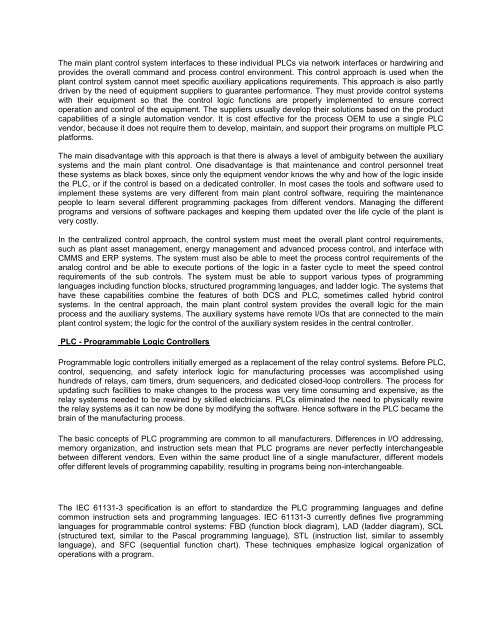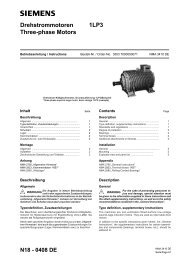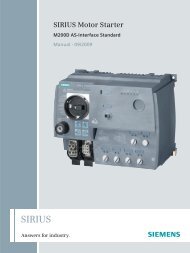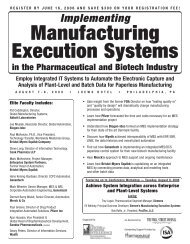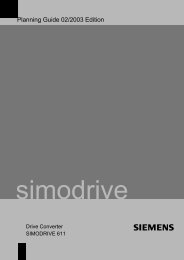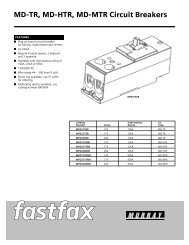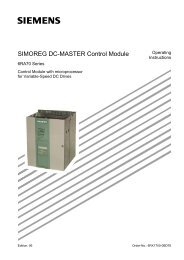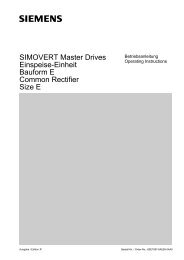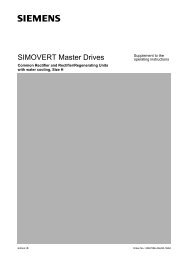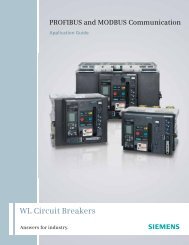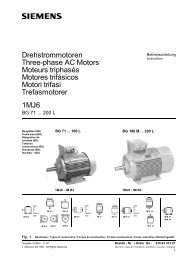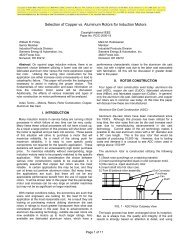Cementing the Relationship Between DCS and PLC: A ... - Siemens
Cementing the Relationship Between DCS and PLC: A ... - Siemens
Cementing the Relationship Between DCS and PLC: A ... - Siemens
Create successful ePaper yourself
Turn your PDF publications into a flip-book with our unique Google optimized e-Paper software.
The main plant control system interfaces to <strong>the</strong>se individual <strong>PLC</strong>s via network interfaces or hardwiring <strong>and</strong><br />
provides <strong>the</strong> overall comm<strong>and</strong> <strong>and</strong> process control environment. This control approach is used when <strong>the</strong><br />
plant control system cannot meet specific auxiliary applications requirements. This approach is also partly<br />
driven by <strong>the</strong> need of equipment suppliers to guarantee performance. They must provide control systems<br />
with <strong>the</strong>ir equipment so that <strong>the</strong> control logic functions are properly implemented to ensure correct<br />
operation <strong>and</strong> control of <strong>the</strong> equipment. The suppliers usually develop <strong>the</strong>ir solutions based on <strong>the</strong> product<br />
capabilities of a single automation vendor. It is cost effective for <strong>the</strong> process OEM to use a single <strong>PLC</strong><br />
vendor, because it does not require <strong>the</strong>m to develop, maintain, <strong>and</strong> support <strong>the</strong>ir programs on multiple <strong>PLC</strong><br />
platforms.<br />
The main disadvantage with this approach is that <strong>the</strong>re is always a level of ambiguity between <strong>the</strong> auxiliary<br />
systems <strong>and</strong> <strong>the</strong> main plant control. One disadvantage is that maintenance <strong>and</strong> control personnel treat<br />
<strong>the</strong>se systems as black boxes, since only <strong>the</strong> equipment vendor knows <strong>the</strong> why <strong>and</strong> how of <strong>the</strong> logic inside<br />
<strong>the</strong> <strong>PLC</strong>, or if <strong>the</strong> control is based on a dedicated controller. In most cases <strong>the</strong> tools <strong>and</strong> software used to<br />
implement <strong>the</strong>se systems are very different from main plant control software, requiring <strong>the</strong> maintenance<br />
people to learn several different programming packages from different vendors. Managing <strong>the</strong> different<br />
programs <strong>and</strong> versions of software packages <strong>and</strong> keeping <strong>the</strong>m updated over <strong>the</strong> life cycle of <strong>the</strong> plant is<br />
very costly.<br />
In <strong>the</strong> centralized control approach, <strong>the</strong> control system must meet <strong>the</strong> overall plant control requirements,<br />
such as plant asset management, energy management <strong>and</strong> advanced process control, <strong>and</strong> interface with<br />
CMMS <strong>and</strong> ERP systems. The system must also be able to meet <strong>the</strong> process control requirements of <strong>the</strong><br />
analog control <strong>and</strong> be able to execute portions of <strong>the</strong> logic in a faster cycle to meet <strong>the</strong> speed control<br />
requirements of <strong>the</strong> sub controls. The system must be able to support various types of programming<br />
languages including function blocks, structured programming languages, <strong>and</strong> ladder logic. The systems that<br />
have <strong>the</strong>se capabilities combine <strong>the</strong> features of both <strong>DCS</strong> <strong>and</strong> <strong>PLC</strong>, sometimes called hybrid control<br />
systems. In <strong>the</strong> central approach, <strong>the</strong> main plant control system provides <strong>the</strong> overall logic for <strong>the</strong> main<br />
process <strong>and</strong> <strong>the</strong> auxiliary systems. The auxiliary systems have remote I/Os that are connected to <strong>the</strong> main<br />
plant control system; <strong>the</strong> logic for <strong>the</strong> control of <strong>the</strong> auxiliary system resides in <strong>the</strong> central controller.<br />
<strong>PLC</strong> - Programmable Logic Controllers<br />
Programmable logic controllers initially emerged as a replacement of <strong>the</strong> relay control systems. Before <strong>PLC</strong>,<br />
control, sequencing, <strong>and</strong> safety interlock logic for manufacturing processes was accomplished using<br />
hundreds of relays, cam timers, drum sequencers, <strong>and</strong> dedicated closed-loop controllers. The process for<br />
updating such facilities to make changes to <strong>the</strong> process was very time consuming <strong>and</strong> expensive, as <strong>the</strong><br />
relay systems needed to be rewired by skilled electricians. <strong>PLC</strong>s eliminated <strong>the</strong> need to physically rewire<br />
<strong>the</strong> relay systems as it can now be done by modifying <strong>the</strong> software. Hence software in <strong>the</strong> <strong>PLC</strong> became <strong>the</strong><br />
brain of <strong>the</strong> manufacturing process.<br />
The basic concepts of <strong>PLC</strong> programming are common to all manufacturers. Differences in I/O addressing,<br />
memory organization, <strong>and</strong> instruction sets mean that <strong>PLC</strong> programs are never perfectly interchangeable<br />
between different vendors. Even within <strong>the</strong> same product line of a single manufacturer, different models<br />
offer different levels of programming capability, resulting in programs being non-interchangeable.<br />
The IEC 61131-3 specification is an effort to st<strong>and</strong>ardize <strong>the</strong> <strong>PLC</strong> programming languages <strong>and</strong> define<br />
common instruction sets <strong>and</strong> programming languages. IEC 61131-3 currently defines five programming<br />
languages for programmable control systems: FBD (function block diagram), LAD (ladder diagram), SCL<br />
(structured text, similar to <strong>the</strong> Pascal programming language), STL (instruction list, similar to assembly<br />
language), <strong>and</strong> SFC (sequential function chart). These techniques emphasize logical organization of<br />
operations with a program.


